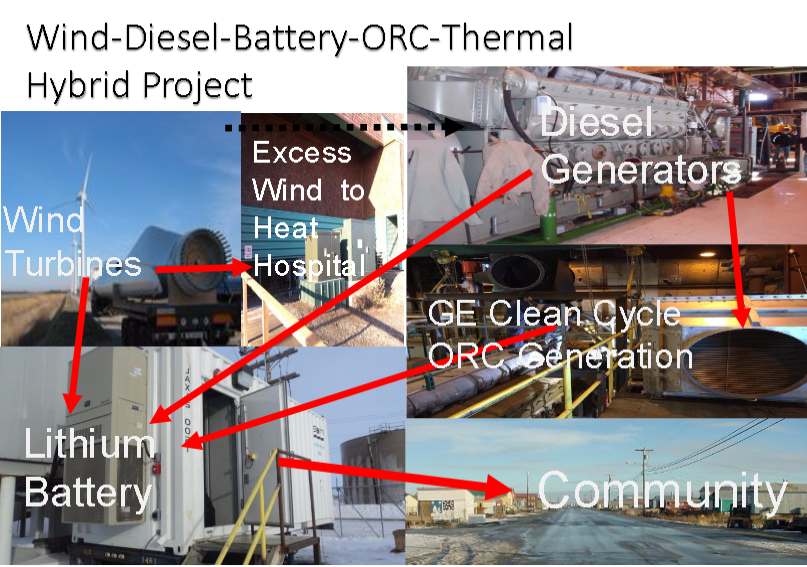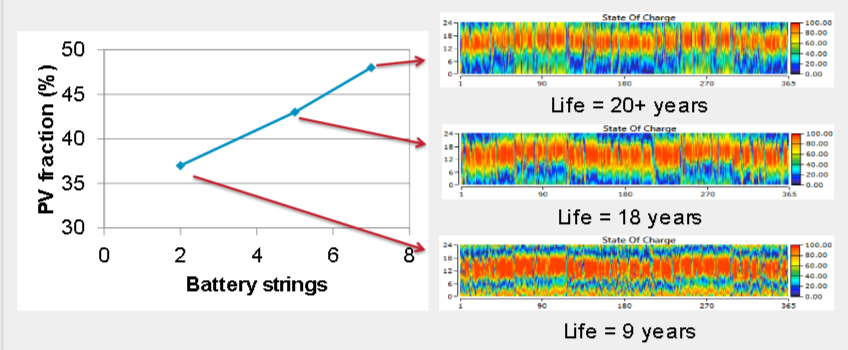HOMER User Case Study: SAFT
The following case study is adapted from a presentation given at the 2016 HOMER International Microgrid Conference. SAFT‘s Stuart Lansburg spoke to attendees about cold-weather storage and SAFT’s approach to these high-tech battery storage systems, presenting two case studies and a critique of HOMER Pro performance.
Importance of storage in remote cold-weather microgrids
When utilized in remote northern microgrids, storage systems enable a high penetration of renewables, producing fuel savings and a return on investment despite the 10% of all energy that is lost passing through ESS. Batteries must be kept small, but not so small as to age prematurely. To reap the rewards of storage, operators should always operate diesels at peak efficiency, in baseload mode, and operate the grid with diesels off.
Storage systems should include a grid-forming converter and Li-ion NCA chemistry for high efficiency and the ability to operate permanently at partial SOC. A ‘cold-weather’ package for Arctic conditions requires high tech insulation for the container and hydronic coil for heating with glycol from the diesel plant.
Case study –Colville Lake
Colville Lake is a First Nation community of 160 residents, located 50 km north of the Arctic Circle, in the Northwest Territories (NWT) of Canada. The airport is not adequate for large cargo delivery and a winter ice road is open only a few weeks each year to bring in the annual diesel supply. The community’s first power generation plant was built in 1990, prior to which there was no community-wide electricity generation.
The challenge
Colville Lake’s diesel-powered generators were at the end of life and needed to be replaced. NTPC looked for innovative alternatives to integrate renewable energy technologies, improve generator efficiency by sharing peak loads, and still reliably meet the community’s growing demand for electricity. The peak demand increased from 40 kW in 1990 to 160 kW in 2014. The new location of the plant also reduced noise and exhaust in the town and presented an opportunity to meet the Government of the Northwest Territories’ (GNWT) goal of expanding renewable energy generation.
The community’s diesel power plant was designed with a load capacity of between 35 kW and 150 kW, which it wished to augment with solar PV. SAFT, a HOMER Pro Gold Partner, performed numerous simulations to help size the PV expansion and analyze fuel consumption. The added renewable energy augments diesel power with 50kW of PV, expanded to 136 kW. SAFT’s storage solution has been found to reduce the community’s diesel consumption by 80,000 liters per year.
The small scale of renewable electricity generation made the economics of this project challenging; however, it represented a lower-risk opportunity to study both the integration of large renewable loads and battery storage in remote communities. The combination of new solar, improved energy efficiency and reduced operating and maintenance costs is expected to add up to $75,000 in annual cost savings.
Case study –Kotzebue Electric

To date, KEA progress on this storage project provides manual dispatch to support high-wind days with the least amount of diesel and fast frequency response (spinning reserves). Upcoming plans include economic dispatch for load leveling, ‘isomode’ for diesel-off operation, and black-start capability for diesel plant station power.
SAFT: HOMER Pro ‘ideal tool’ for extreme cold modeling
Storage provides opportunities for deploying hybrid powering in remote Alaskan and Canadian communities, but authorities require a business plan before securing funding. HOMER Pro is the ideal tool for this purpose, providing detailed results with limited inputs. HOMER Pro provides a high-level approach to ESS sizing, offering varying levels of input detail and enabling the building of a financial model.

“The Colville Lake and KEA projects are demonstrating what fuel savings can be achieved with large scale deployments of renewables with storage,” concludes SAFT’s Jim McDowell. “Now, opportunities are coming up with other villages. That is where HOMER Pro comes into its own, allowing us to propose less-conservatively sized systems with limited data.”
